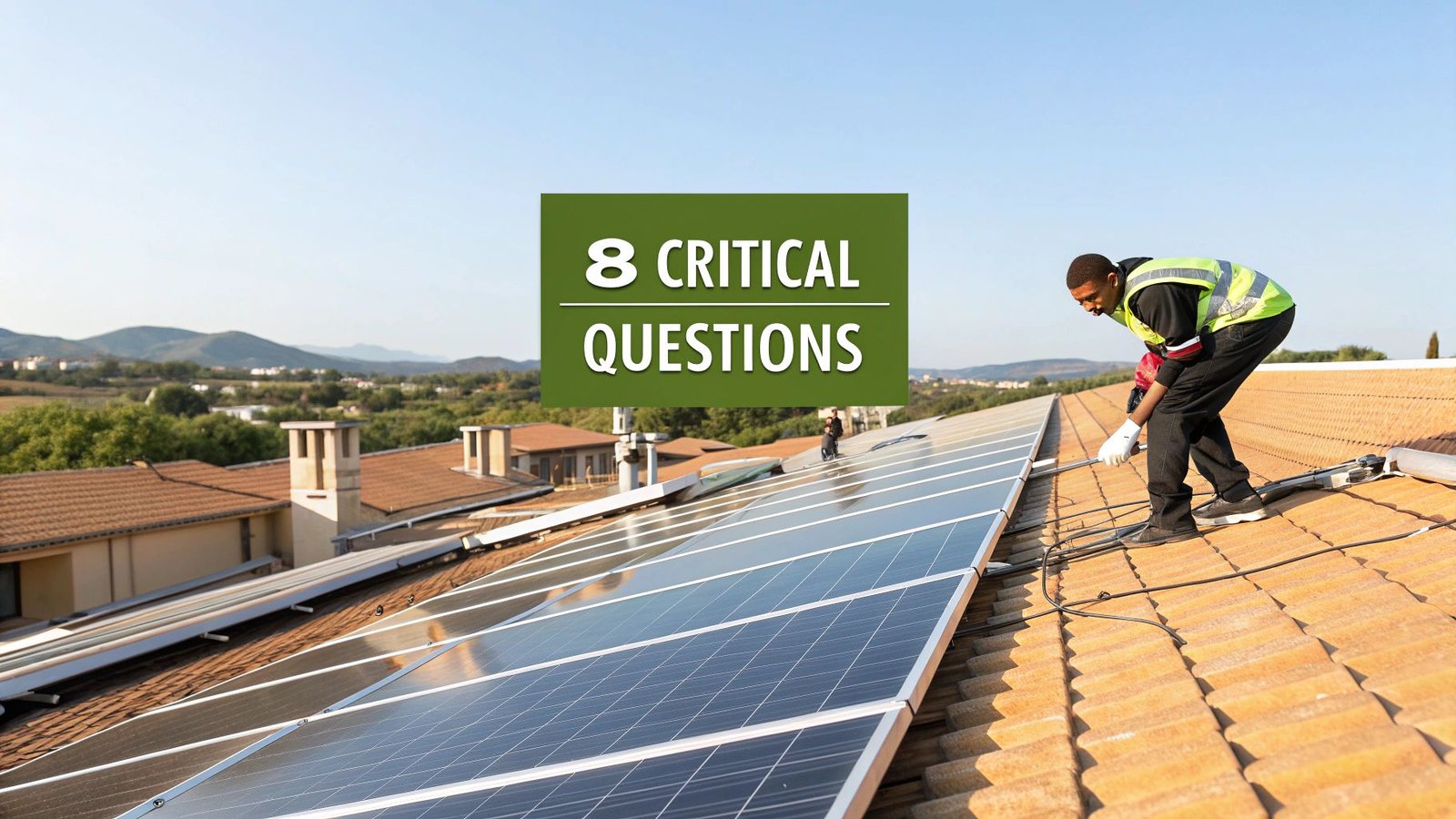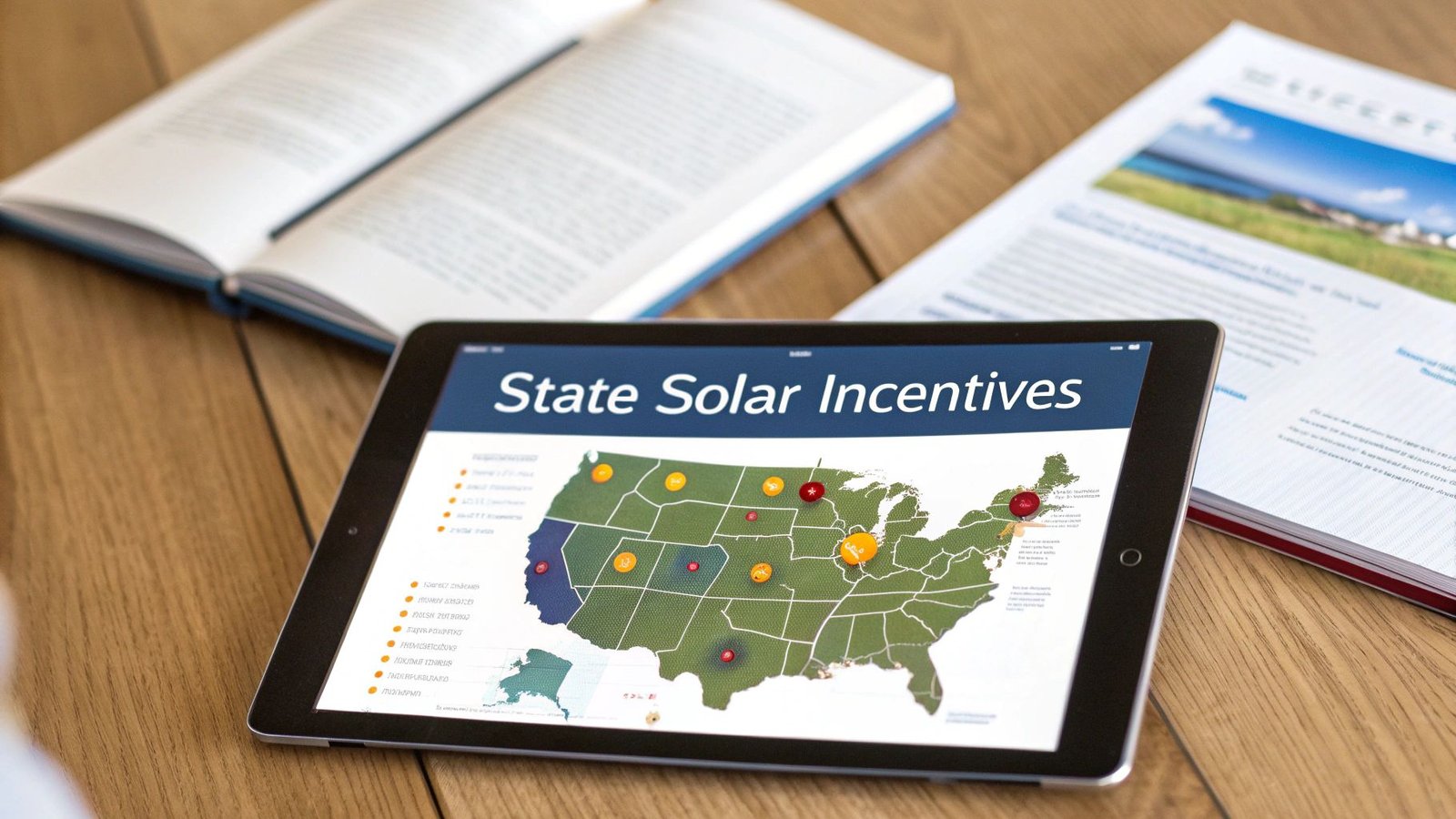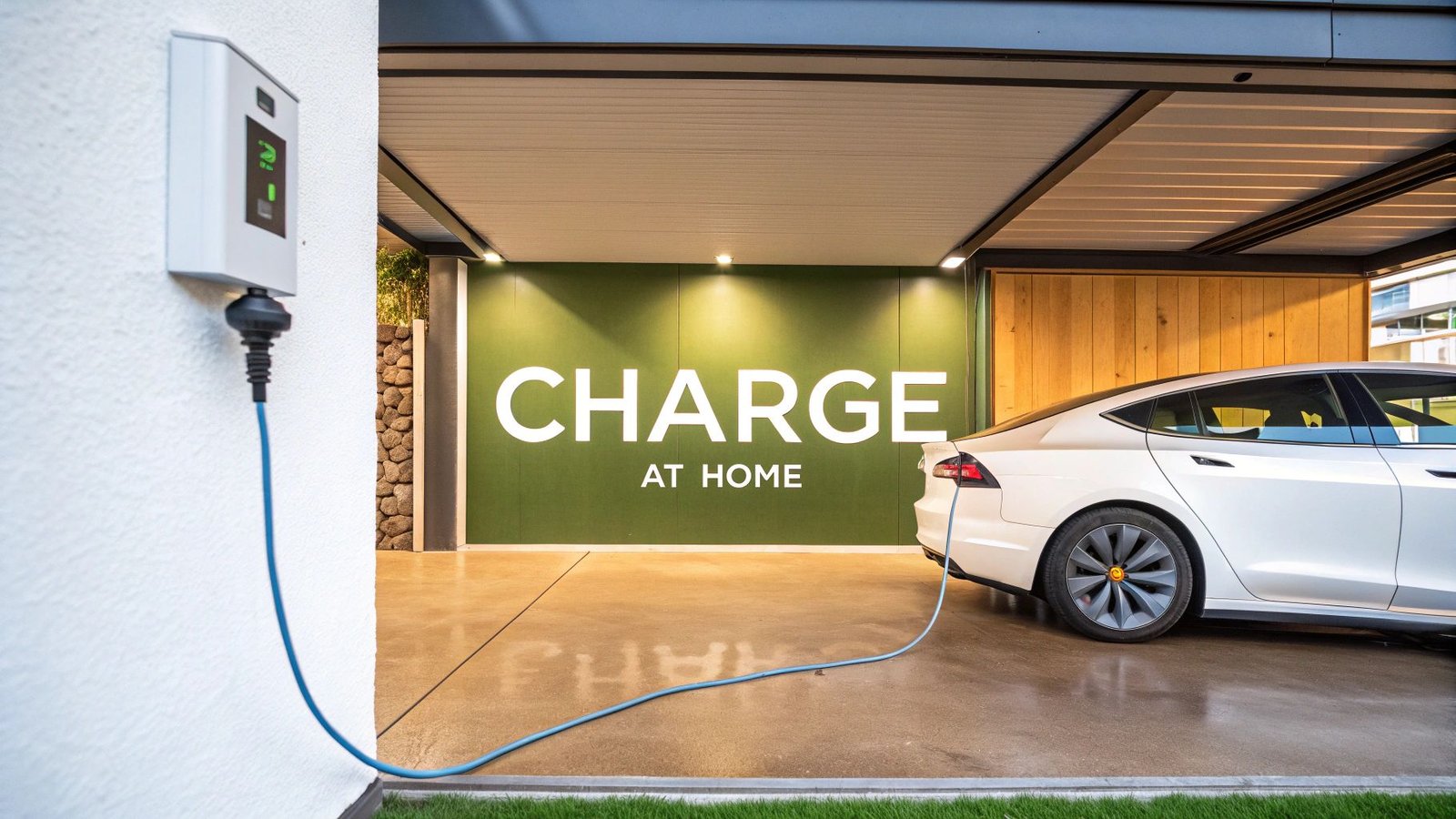Let's get straight to the point: what does a home solar system actually cost?
For most homeowners, the initial, all-in price tag lands somewhere between $15,000 and $25,000. But hold on—that's before any incentives kick in. Once you factor in the 30% federal solar tax credit, that number shrinks significantly, bringing the final cost down to a much more manageable $10,500 to $17,500.
Your Quick Answer to Home Solar Costs
Think of that initial price as a complete, turnkey investment. It’s not just for the solar panels themselves; it covers everything needed to get your home running on sunshine for the next 25-30 years.
As we head into 2025, the industry standard for measuring solar cost is "price per watt." Right now, that's hovering between $2.50 and $3.50 per watt. It's a handy metric for comparing quotes from different installers. For a typical family home, this translates into that $15,000 to $25,000 range before you touch any incentives.
Thankfully, the federal government offers a massive helping hand. The solar tax credit allows you to slash your federal tax bill by 30% of the total system cost, which is a huge chunk of savings. If you want to dive deeper into the numbers, you can explore detailed solar panel cost data from recent industry analysis.
Estimated Home Solar System Cost at a Glance
To put these numbers into perspective, here’s a simple chart breaking down what you can expect to pay for a standard residential solar system. It clearly shows the starting price and how the federal tax credit dramatically lowers your final investment.
graph TD
subgraph Cost Breakdown
A[Gross System Price: $15,000 - $25,000] --> B{Federal Tax Credit};
B -- 30% Savings --> C[Net System Cost: $10,500 - $17,500];
end
style A fill:#f9f,stroke:#333,stroke-width:2px
style C fill:#ccf,stroke:#333,stroke-width:2px
That net cost is the number that really matters for your budget. It’s what you’re truly investing after taking advantage of the biggest solar incentive out there.
It’s helpful to view this as a long-term investment, not just another home expense. The money you put in upfront starts paying you back immediately with lower (or even non-existent) monthly electricity bills. Over time, those savings really add up, delivering a solid return on your investment.
Now that you have the bottom-line numbers, let's break down exactly what goes into that final price.
Breaking Down What You're Actually Paying For
When you get a solar quote, it's natural to think the price tag is all about those shiny panels on the roof. But that’s only part of the story. The total cost is really a mix of two different categories: hard costs y soft costs. Getting a handle on this split is the key to understanding where your money is actually going.
pie
title Total Solar Project Cost Breakdown
"Hard Costs (Equipment)" : 45
"Soft Costs (Labor, Permits, etc.)" : 55
Hard costs are exactly what they sound like—the physical, tangible pieces of equipment that make up your solar system. This is the hardware you can see and touch.
- Solar Panels: This is the most visible part. You’ll have a choice between standard, budget-friendly panels and premium, high-efficiency models.
- Inverters: Think of this as the system's brain. It's the crucial piece that converts the DC electricity from your panels into the AC power your home can use.
- Mounting Hardware: These are the racks, clamps, and bolts that securely fasten everything to your roof.
All this gear typically makes up about 40% to 50% of your total project cost.
The Overlooked Soft Costs
So, where does the other half of the money go? That's where "soft costs" come in. These are all the services and behind-the-scenes work needed to get your system designed, approved, and installed. They might be less visible, but they're every bit as important as the hardware.
Soft costs can represent over half of a residential solar installation's final price. They include everything from labor and customer acquisition to permitting fees and system design.
These are the costs for the skilled crew that will spend days on your roof, the engineers who custom-design a system perfect for your home's energy needs, and the administrative team handling all the local permits and inspections. A full breakdown of the coste de instalación de un sistema de paneles solares reveals just how much goes into the final price beyond the equipment.
One other major factor to consider is the condition of your roof. If it's nearing the end of its life, you’ll need to factor in the average cost of a new roof before installing panels on top of it. It’s a significant expense that can sometimes catch people by surprise.
The infographic below really helps visualize how you get from the initial system price to your final out-of-pocket cost, especially after incentives like the federal tax credit.

As you can see, that 30% tax credit makes a huge dent in the final number, bringing the investment down to a much more manageable level for many homeowners.
Why Your Quote is Unique
You'll quickly discover that no two solar quotes are the same, and that’s because no two homes are the same. Your final price is a custom blend of all these hard and soft costs, tailored specifically to your property.
Things like the brand of panels you choose, the complexity of your roof (think steep pitches or multiple angles), and even local labor rates can shift the numbers. This is why a generic online estimate can only get you so far. Getting a custom quote is the only way to know the true cost for your home, and understanding this breakdown will help you have a much better conversation with your installer.
How Your Home and Location Shape Solar Costs
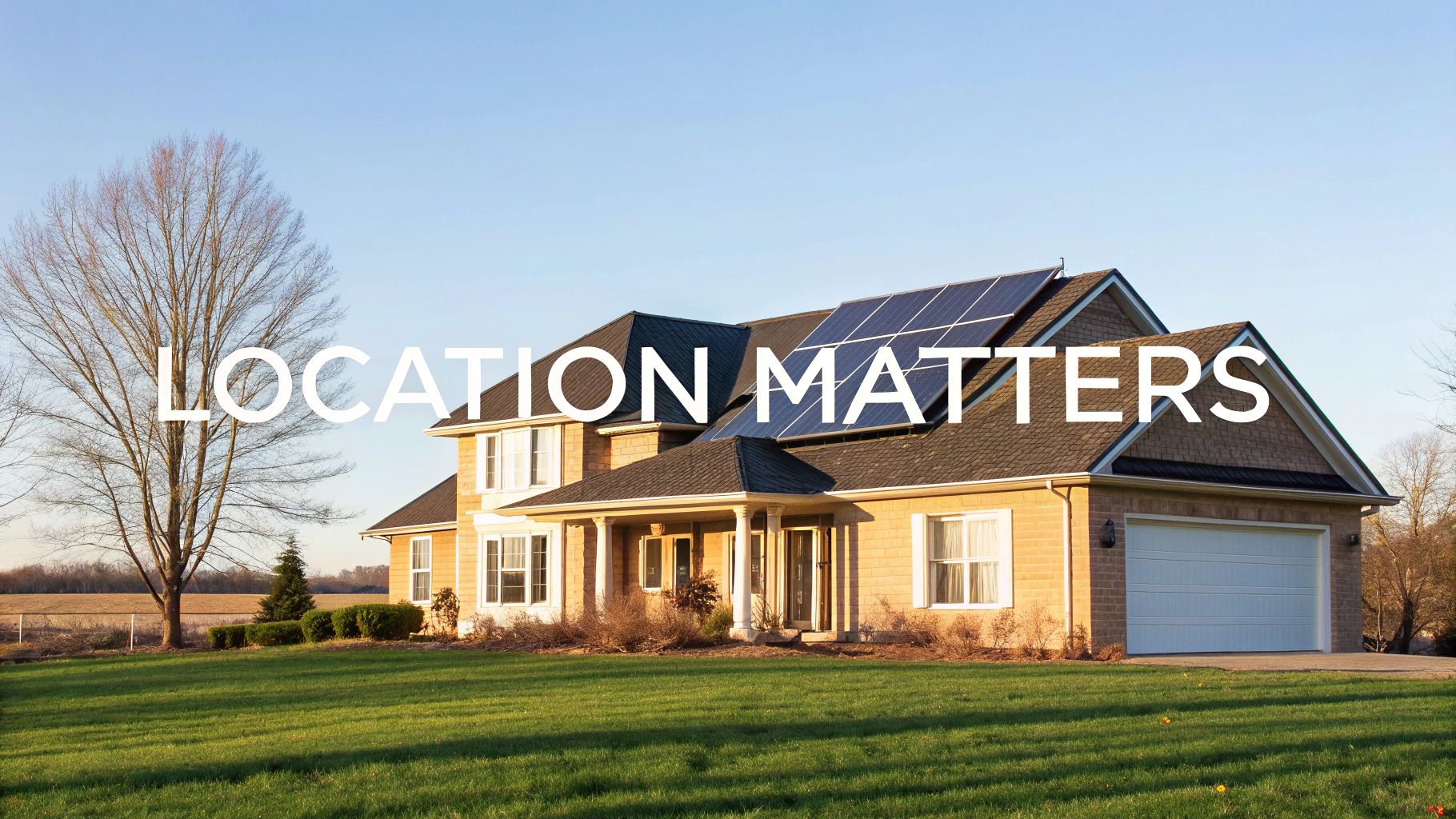
If you've ever wondered why there isn't a single, flat price for going solar, the answer is simple: every home is unique. The average cost for home solar is a great starting point, but your final price tag is a custom-fit number. It all boils down to three key things: your family's energy appetite, where you live, and the condition of your roof.
Think of it like buying a new furnace or air conditioner. You wouldn't expect the same unit to work for a cozy two-bedroom bungalow and a sprawling five-bedroom house. Solar is no different. The more electricity you use, the larger the system you'll need to power your life, and the higher that initial investment will be.
This is exactly why solar installers always ask to see your old utility bills. They aren't just being nosy—they're figuring out your home's energy "diet" to design a system that produces just the right amount of power for you.
Your Energy Consumption Drives System Size
The single biggest factor in your total solar cost is the size of the system, which we measure in kilowatts (kW). And system size is a direct reflection of how much power you use month to month.
A family with an electric vehicle, a heated pool, and central A/C blasting all summer will need a much beefier (and pricier) system than a smaller, more energy-conscious household. The whole point is to generate enough electricity to cover as close to 100% of your annual usage as possible.
The bigger your electricity bill, the more solar panels you'll need. However, larger systems often have a lower cost-per-watt because soft costs like permitting and design don't scale up at the same rate.
It seems a little counterintuitive, but a larger initial investment for a high-energy home often leads to a faster payback. Why? Because the savings you see on your monthly bill are just that much more dramatic.
How Geography and Location Impact Pricing
Where you live plays a huge part in the final numbers. And it’s not just about how much sunshine you get; it’s also about the local market and all the red tape involved.
- Sunlight Availability: It’s no surprise that a home in sunny Arizona will squeeze more power out of a single panel than one in cloudy Oregon. This means a home in a less sunny state might need a bigger or more efficient—and therefore more expensive—system to produce the same amount of electricity.
- Local Labor Rates: Just like any other skilled trade, the cost of electricians and installers varies quite a bit from one state to another.
- Permitting and Regulations: Some towns have a simple, straightforward permitting process. Others can be a bureaucratic nightmare. Those complexities and fees get rolled into the "soft costs" of your installation.
Your Roof’s Role in the Final Cost
Finally, let's talk about your roof. It's the foundation of your solar system, and its condition and design are major variables. The perfect roof for solar is south-facing, has a gentle slope, and is in great shape. Anything different can add to the final price.
For instance, a complicated roof with lots of different angles, dormers, and vents needs more planning and specialized mounting gear. The roofing material itself matters, too. Putting panels on a standard asphalt shingle roof is usually cheaper than on a tile or metal roof, which takes more labor and different equipment.
The panel technology itself is always getting better. Most new systems use advanced, double-sided 'TOPCon' polysilicon panels, which are known for being incredibly efficient and durable. This tech has become the new standard, and it’s one reason the average cost for home solar has nudged up slightly, even though prices are still near historic lows. You can dig deeper into solar panel price trends on Inside Climate News to see what’s been happening.
Unlocking Savings with Solar Incentives and Rebates
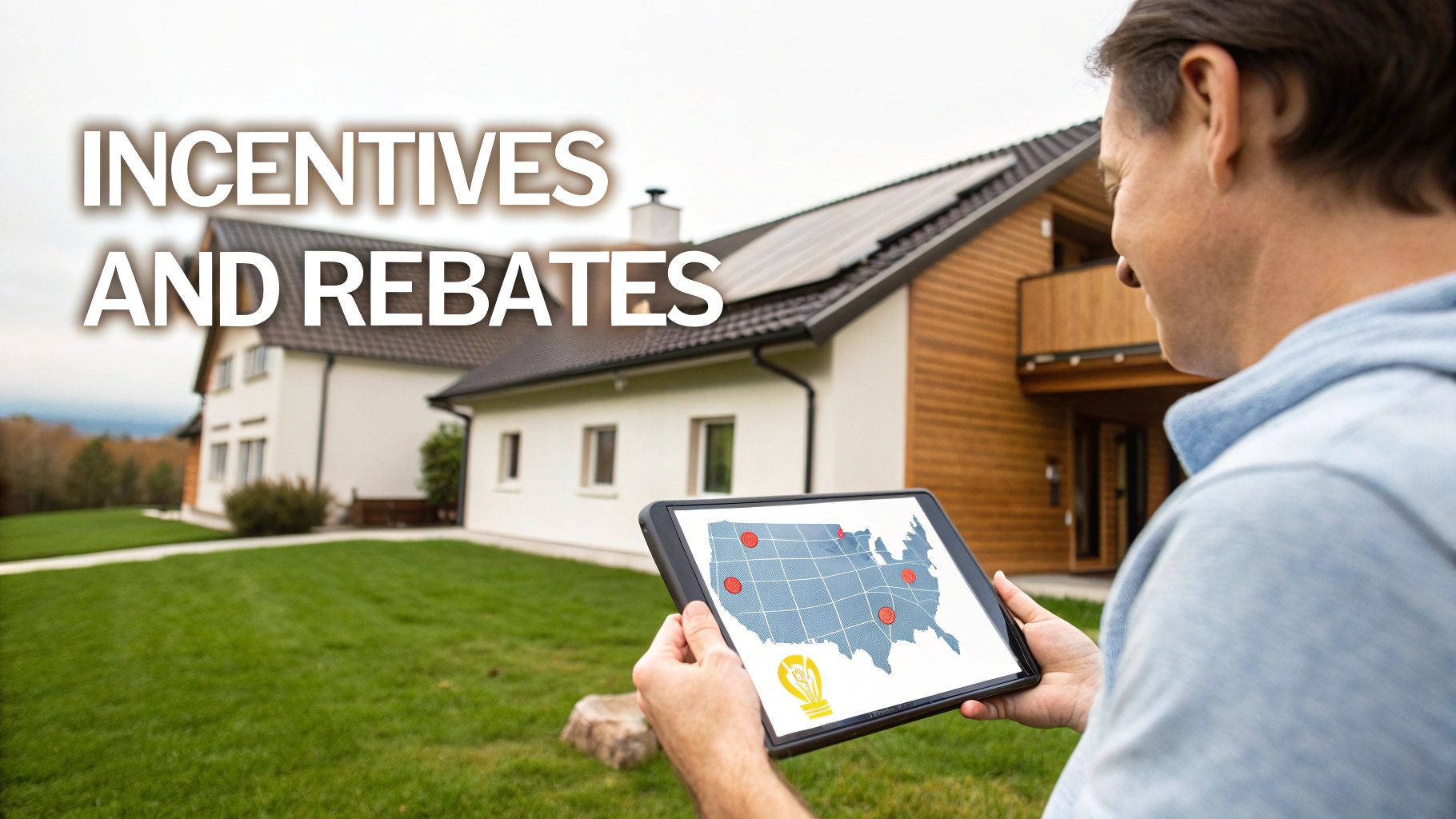
The initial quote you see for a new solar panel system is just that—a starting point. It’s a lot like the sticker price on a new car. It's the big number you see antes de all the powerful discounts and financial incentives are applied.
These incentives are put in place specifically to lower the average cost for home solar, making the switch a whole lot more affordable for homeowners like you.
Explicación del crédito fiscal federal para la energía solar
The biggest financial game-changer is the federal Solar Investment Tax Credit, or ITC. This isn't a check in the mail, but rather a dollar-for-dollar reduction in the federal income taxes you owe. It allows you to claim 30% of your total system cost as a credit, which massively slashes your net investment.
Let's say your system costs $20,000. The ITC would give you a $6,000 tax credit, knocking your effective cost down to just $14,000. It's a powerful and direct reward for investing in clean energy for your home.
To be eligible for this fantastic incentive, there are just a few simple boxes to check:
- You must own the solar panel system (leasing doesn't count).
- The system needs to be brand new and installed at your primary or secondary home in the United States.
- You need to have enough federal tax liability to actually use the credit.
This credit alone makes a world of difference in the financial breakdown of going solar. You can explore a more detailed guide on solar panel installation costs to see how the ITC fits into the complete budget.
Beyond Federal Savings: State and Local Incentives
The savings don't stop at the federal level. Far from it. Many states, local governments, and even individual utility companies have their own programs to sweeten the deal for homeowners making the switch. The best part? These incentives can often be stacked on top of the federal ITC, driving your costs down even further.
These layered incentives are a game-changer. The federal tax credit, combined with state and local rebates, can reduce overall costs by 30–50%, making solar a much more attainable goal for many families.
Keep an eye out for these common types of local incentives:
- Créditos fiscales estatales: These work just like the federal ITC but apply to your state income tax bill instead.
- Reembolsos en efectivo: Some utilities or local programs offer a straightforward cash rebate once your system is up and running.
- SRECs (Solar Renewable Energy Certificates): In certain states, you earn these "certificates" for the clean energy your system generates. You can then sell your SRECs to utilities, creating a nice little income stream.
This powerful combination of federal, state, and local programs is what truly makes the average cost for home solar so manageable. The trick is to do your homework and find out what's available where you live, because these programs can change dramatically from one town to the next. Working with an experienced local installer is your best bet for finding every last dollar of savings you're entitled to.
Calculating Your Solar Payback Period and ROI
https://www.youtube.com/embed/ObS1K6oAGE8
The smartest way to look at solar panels is to see them as a long-term investment, not just another home expense. To really grasp their value, the first thing we need to figure out is your solar payback period. This is simply the time it takes for the savings on your electricity bill to completely pay off the initial cost of the system.
Think of this calculation as your financial North Star. It helps you look past the upfront average cost for home solar and pinpoint the exact moment your system stops being a cost and starts putting money back in your pocket.
The Payback Period Formula
At its heart, the payback period is a straightforward idea. You just take the total net cost of your system (after all the discounts and incentives are applied) and divide it by what you expect to save on power bills each year.
- Coste neto del sistema: This is the final price you pay after subtracting the Crédito fiscal federal 30% and any other local or state rebates you qualify for.
- Annual Savings: This is the amount of money you'll keep in the bank each year instead of sending it to the utility company. It's based on how much electricity you typically use and what your local utility charges.
Let's run a quick example. If your net cost for the system is $14,000 and your projected annual savings are $1,750, your payback period is eight years ($14,000 / $1,750 = 8). After year eight, every bit of energy your panels generate is pure profit.
Understanding Your Return on Investment
The payback period is a fantastic starting point, but the Return on Investment (ROI) gives you the complete financial story over the system's entire 25- to 30-year lifespan. It's a simple percentage that shows you how profitable your solar investment truly is.
For most homeowners, the average ROI for a solar system lands somewhere between 10% and 20%. That’s a solid return that holds its own against many traditional stock market investments. What's more, your ROI can get even better over time, thanks to one major factor: rising utility rates.
As the price of electricity from the grid inevitably goes up, the value of the energy your solar panels produce also increases. This means your annual savings actually grow over the years, which can significantly shorten your payback period and give your overall ROI a serious boost.
This is what makes solar such a brilliant hedge against energy inflation. While your neighbors are wincing at higher bills, yours can stay low and predictable—or even disappear entirely.
To get a personalized estimate, you can plug your own numbers into our https://radiantenergysolar.com/solar-return-on-investment-calculator/ and see the potential for yourself.
The financial argument for solar has only gotten stronger over the years. This chart shows the dramatic decrease in solar panel costs over the last decade.
xychart-beta
title "Global Solar Panel Cost Drop (2014-2024)"
x-axis [2014, 2016, 2018, 2020, 2022, 2024]
y-axis "Cost" [0, 25, 50, 75, 100]
line [100, 75, 50, 30, 15, 10]
In fact, the global cost of solar panels has dropped by a staggering 90% since 2014. While there are always small market ups and downs, the long-term trend is crystal clear: solar is an increasingly accessible and intelligent financial move.
If you're interested in comparing solar to other potential investments, it's helpful to understand the basic mechanics of how to calculate return on investment in general. This can give you a clearer picture of where solar stands among other home improvement projects you might be considering.
Common Questions About Home Solar Costs
Even with all the numbers laid out, you probably still have a few practical questions kicking around in your head. That's completely normal. Getting a handle on the real-world financial details beyond that initial quote is what helps you feel truly confident about making the switch to solar.
Let's walk through some of the most common questions homeowners ask when they're getting serious about going solar.
Are There Financing Options for Solar Systems?
Yes, and thankfully, you almost never have to pay for the whole system in one lump sum. The solar industry has come a long way, and today there are several well-established financing paths that make the average cost for home solar much more manageable.
- Solar Loans: This is the most popular route by far. Think of it like any other home improvement loan. You borrow the money, you own the system from day one, and you get to claim all the juicy financial perks, like the federal tax credit.
- Solar Leases and PPAs: With a lease or a Power Purchase Agreement (PPA), you're essentially "renting" your roof to a solar company. They install their panels on your home for little or no money down, and you agree to buy the power they generate at a fixed monthly rate. You don't own the equipment, but you can still save a bundle on your electric bill.
Each route has its pros and cons when it comes to ownership, how much you save over the long haul, and who gets to pocket those valuable tax credits.
What Are the Real Costs of Solar Panel Maintenance?
Here's some great news: solar panels are incredibly low-maintenance. They're built tough and, for most people, Mother Nature does all the cleaning. A good rainstorm is usually all it takes to wash off the dust and pollen that builds up over time.
The one component you should plan for down the road is the inverter. This is the workhorse of your system, and it typically needs replacing once over the 25- to 30-year life of your panels. Expect that to cost somewhere between $1,000 and $3,000 when the time comes, usually in about 10-15 years. Outside of that, your ongoing maintenance costs should be next to nothing.
Will Installing Solar Panels Increase My Homeowners Insurance?
Most likely, yes—but don't panic. The increase is usually pretty small. You're adding a valuable asset to your property, so it only makes sense to update your homeowners insurance policy to make sure it's covered.
Be sure to give your insurance provider a heads-up before the installation crew shows up. This ensures your system is protected from day one against any unexpected damage.
Most insurance companies will just make a minor adjustment to your premium. For the peace of mind you get, it's a small price to pay.
How Much Does Panel Brand Affect the Total Cost?
The brand you choose can definitely move the needle on your total cost. In early 2025, solar panel prices in the U.S. were hovering around 33.7 cents per watt, partly due to tariffs and market forces. For comparison, prices in China were closer to 10.1 cents per watt. That gap really shows how much equipment choices can impact the final price tag. You can dig deeper into these solar price trends on Inside Climate News.
So what's the right move? Premium, high-efficiency brands will cost more upfront but often deliver better performance and rock-solid warranties. On the other hand, more budget-friendly brands can still provide a fantastic return on your investment, even with slightly lower efficiency. It all comes down to your budget, your energy goals, and the amount of usable space on your roof.
Ready to see what a solar investment could look like for your home? The experts at Energía radiante can provide a custom quote tailored to your specific energy needs and help you navigate every available incentive to maximize your savings. Take the next step toward energy independence and contact us today at https://radiantenergysolar.com.


